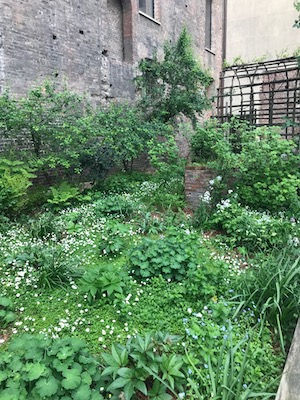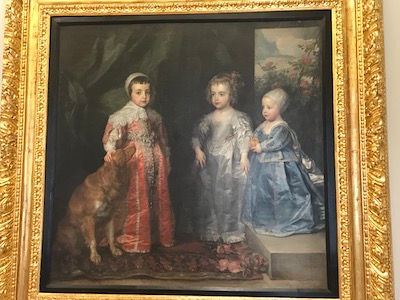Royal Museums
- Amy Unfried
- May 4, 2019
- 4 min read
Turin's Musei Reali, or Royal Museums, are a large complex of buildings and gardens that make up what I have read is the largest royal palace in Europe: the Palazzo Reale, the Royal Palace where the Dukes of Savoy and subsequently the Kings of Italy made their home, is, with its accessory buildings and grounds, larger than Versailles and other very splendid claimants to the title of Best Something-or-Other Palace. (I have not attempted to verify this claim.) In the past two days, we've visited the two highest-rated component attractions (two stars in Michelin's Guide Verte--nothing in Turin gets three stars): the Palazzo Madama (the Palace of the Dowager Duchesses) and the Galleria Sabauda (the Savoy Art Collection). Both of them are grand art museums.

The Palazzo Madama started as a Roman gate, became a small fort during the Middle Ages, then a castle for the princes of Acaja in the fifteenth century (Acaja was a noble family that married into the Savoys, or vice versa), and in the sixteenth and seventeenth centuries it was the home of two dowager duchess of Savoy, and subsequent duchesses. In 1832 the King of Sardinia, who was a Savoy, made it the locale for the royal art collection, and in 1848 it was the first Senate for the Kingdom, that is, for those parts of the country that had by then consolidated to begin forming the Italian nation. Since 1934 it has housed the collections of Turin's Civic Museum of Ancient Art.

The ground floor houses Gothic and Renaissance art from the thirteenth through sixteenth centuries, with an emphasis on Piedmontese artists, and it turned out to be the part we were most interested in, though I can't possibly share with you all the art we especially enjoyed there. Oh well, if you insist, here are a few, but only a few:
This delightful whimsical carving of a cherub pulling the hair and beard of a tolerantly smiling grotesque winged serpent is from an early 16th century choir stall, which also has three other very different but equally delightful imaginary creatures interacting in amusing ways.

I loved this carving showing the crowning of the Virgin, with saints. It came from an altarpiece and is dated 1295-1300, but it looks as though it had been finished yesterday, so they have clearly had it restored in a major and highly successful way quite recently. The same was true of other polychromed carvings in the collection.

The central carving in walnut wood by a south German carver depicts the Annunciation, and the frame around it depicts "Jesse's Tree," the family tree of the Old Testament Jesse who was the father of King David and an ancestor of St. Joseph and thus of Jesus. The carving of the frame is especially wonderful with all the little people in amongst the vines.

One of Steve's favorite things was our discovery of an artist previously unknown to us, named Defendente Ferrari. The Madama's collection included quite a few of his works, and we both liked them. The wall text says, "He is one of the most interesting Renaissance painters. Born in Chivasso, he trained in Martino Spanzotti's studio and is documented in Piedmont from 1509 to 1535. He created a personal style of great appeal, steeped in Northern influences and with a particular eye for the preciousness of materials, which he rendered with great emotional and devotional intensity." This painting depicts Jesus Among the Doctors at the Temple.

The next upper floor houses the baroque apartments that the royal ladies lived in, and we couldn't see much of those rooms because they required a separate ticket that we hadn't realized we needed, but here's a glimpse of a ceiling in one of the rooms, picturing the apotheosis of the duchess, being crowned in celestial glory.

The top floor is decorative arts--porcelain and majolica china, blown and painted
glass, jewelry, ivories, small bronzes. The
bottom floor is at moat level, where there is a garden of all the things that research indicates were grown there in the 15th century, when they employed fifty full-time gardeners. We saw half a dozen gardeners whom we assumed to be volunteers.
From the top floor there's a panoramic view of the city and its surroundings. It was too cloudy to see the mountains.

The next day, we visited the Galleria Sabauda, the Savoy Collection, a two-star-rated art museum, but we didn't enjoy it as much as we expected, because large parts of it are in the process of reinstallation, and while the parts we did see included some works that we admired very much, there were a lot of Baroque-period paintings that we didn't think measured up to the others, and Steve is not fond of the Baroque at all anyway. There were some nice works by Canaletto and Guardi, Tiepolo and Veronese, a Rubens, a Rembrandt, a Bronzino, quite a few Dutch landscapes and still lifes, two sibyls by Angelica Kauffmann, and an interesting bunch of enamel-on-porcelain small-scale copies of famous paintings like Titian's Venus of Urbino.

I liked this Van Dyck portrait of the three oldest children of King Charles I of England in 1635: two of them became King (Charles II, 1660-85, and James II, 1685-88), and little Princess Mary married William II of Orange, was the mother of the next William of Orange who married his first cousin Mary, the daughter of James II, and in 1689 they assumed the throne together as William III and Mary II.



Comments